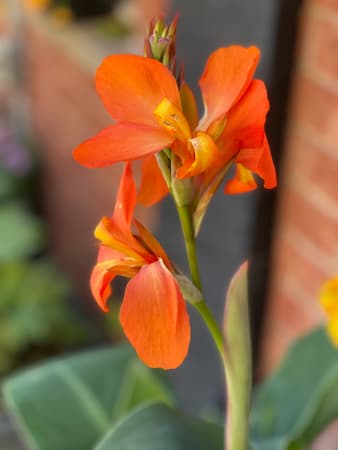How to Grow and Care for Canna Flowers

About Growing Canna Plants in Your Home Flower Garden
Homeowners who grow Canna flowers do so for two big reasons. First, these plants have bright and attractive foliage. Some gardeners and homeowners find the foliage so attractive, that they grow these plants solely for their foliage. Second, Canna lilies have colorful gladiolus-like flowers. And, they come in a wide variety of colors. Isn’t it about time you started growing Canna plants, too!?
Cannas are tropical and sub-tropical plants They are native to Asia and Latin America. Also, they are called “Indian Shot”, getting their name from their hard, pea-like seeds. There are many varieties suitable for your garden or for use as container plants. There are even varieties of this plant that are grown in water.
Note: These flowers attract hummingbirds…..cool!
Flowers Bloom: Summer
Flower Colors: Colors include apricot, coral, light orange, pink, red, and yellow.
Plant height: 1.5 to 10 feet, depending upon variety.
Plant Hardiness Zones: 8 – 11
Canna Flower Plant Propagation
Most home gardeners grow Canna lilies from rhizomes. This tropical plant is sensitive to the cold and is killed by frost or freezing temperatures. As a result, the rhizomes need to be pulled up and stored indoors over winter in colder regions of the country. After the plants have died back in the fall, dig up the roots. Clean and store them in a cool, dark area until planting the following spring. Canna plants can also be propagated from seed. If you grow them from seed, it will take longer for the plant to grow. And, the flowers may not bloom until the second year.
The number of eyes on the rhizome is an indicator. The more eyes on the rhizome, the bigger the plant, and the plant will usually produce more blooms.
The soil at planting time should be 65° F or higher.
In southern areas, they can remain in the ground over winter. Add a heavy layer of mulch to protect the rhizomes from freezing.
Rhizome Planting Depth: Plant rhizomes 3 to 4 inches deep.
Final Plant Spacing: 4 to 8 inches apart.
How to Grow Cannas Flowers
Plant rhizomes in the spring. Canna plants prefer rich, organic soil. Plant in full sun. Normally, the plant lives 3-5 years. So, select a panting site where they will be undisturbed for years.
Canna lilies need plenty of water, but the soil should be well-draining (except for varieties grown in water). The best plan for watering is to provide a consistently moist, but not wet, soil.
Divide roots, leaving one or two growing tips on each section. Plant roots 3 to 4 inches deep, separated one to three feet apart. Mix in plenty of compost and organic matter during planting. The plant will grow rapidly in the warmth of early spring. Often, young Canna plants will bloom in the first year, especially in warmer climates. And, in warmer regions, they may bloom more than once a season.
Apply a nitrogen-rich fertilizer in the spring. Then, as the season progresses, apply a fertilizer high in phosphorus to promote blooms.
If you experience a lack of Canna flowers, it is likely caused by one of the following causes: insufficient sunlight, a lack of phosphorus, or too much nitrogen, or an unhealthy plant.
Mulch around plants heavily every year to help retain water, and replenish organic matter.
Avoid overcrowding plants. Overcrowding results in smaller, less healthy plants. And, the plant produces fewer and smaller blooms. Separate and replant established plants every three to four years.
If you experience a lack of blooms,
In the fall, dig up the roots for storage. The roots die in cold and freezing winter soils. The roots will survive over-wintering outdoors only in the warmest areas of the country.
Ideal Soil pH: 6.0 – 8.0
Insects and Plant Disease
Insect and disease problems are infrequent.
The waxy surface of the plant helps to avoid plant fungus and other disease. Rust and bacterial light can occasionally occur.
Use insecticides, organic repellents, and fungicides only as needed.
Related Articles
Also, people who read this article will like:
Flower Gallery Find pictures of your favorite flowers.
Buy Bulbs and Plants – Enjoy this unique bloomer.
Please support our site. Shop for:
- rmmatthews100@hotmail.com
- 585-721-6528
- Rochester, NY
©1999-2024 GardenersNet.Com, All Rights Reserved

